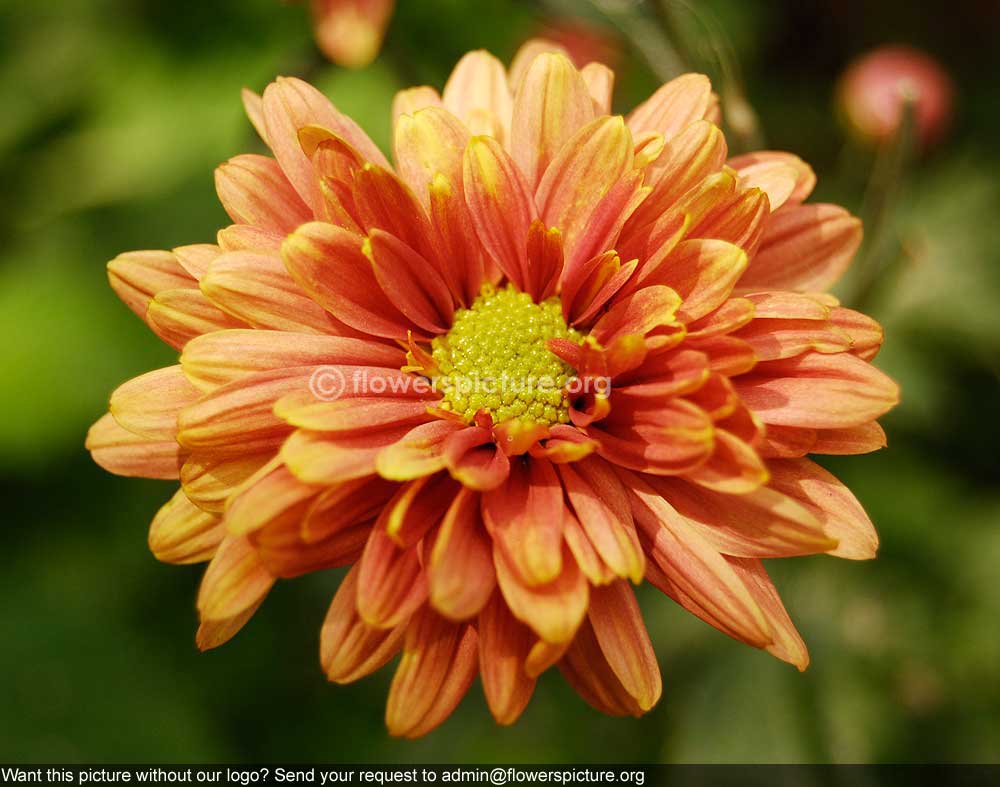
Chrysanthemums, sometimes called mums or chrysanths, are flowering plant life of the genus Chrysanthemum in the family Asteraceae. They are native to Asia and northeastern The european countries. Most species originate from East Asia and the center of diversity is in China. There are many horticultural varieties and cultivars. The name "chrysanthemum" comes from the Ancient Greek:?????? chrysos (gold) and Aged Greek:??????? anthemon (flower).
Taxonomy
The genus once included more species, but was split several decades ago into several genera, putting the economically important florist's chrysanthemums in the genus Dendranthema. The naming of the genera has been contentious, but a ruling of the International Botanical Congress in 1999 changed the defining species of the genus to Chrysanthemum indicum, restoring the florist's chrysanthemums to the genus Chrysanthemum.The other species recently included in the narrow view of the genus Chrysanthemum are now utilized in the genus Glebionis. The other genera separate from Chrysanthemum include Argyranthemum, Leucanthemopsis, Leucanthemum, Rhodanthemum, and Tanacetum.
Description
Outdoors Chrysanthemum taxa are herbaceous perennial plants or subshrubs. They have alternately organized leaves divided into booklets with toothed or from time to time smooth edges. The chemical substance inflorescence is an series of several flower mind, or sometimes an one head. The head has a base covered in layers of phyllaries. The simple row of beam florets are white, yellowish or red; many horticultural specimens have been bred to bear many series of ray florets in a great variety of colors. The disc florets of wild taxa are yellowish. The fruit is a ribbed achene. Chrysanthemums, also known as 'mums', are one of the lovliest varieties of perennials that start blooming early in the fall. This is also known as favorite flower for the month of November.
Modern developed chrysanthemums are showier than their wild relatives. The flower heads occur in various forms, and is daisy-like or decorative, like pompons or buttons. This genus contains many hybrids and thousands of cultivars developed for horticultural purposes. As well as the traditional yellow, other colors are available, such as white, purple, and red. The main hybrid is Chrysanthemum x morifolium (syn. C. x grandiflorum), derived primarily from C. indicum, but also involving other varieties.Over 140 varieties of chrysanthemum have gained the Royal Horticultural Society's Prize of Garden Merit.
Chrysanthemums are broken into two basic groups, garden hardy and exhibition. Garden hardy mums are new perennials capable of wintering in most northern latitudes. Exhibition kinds are not usually as sturdy. Garden hardies are defined by their capacity to produce an abundance of small blooms with little if any mechanical assistance, such as staking, and withstanding wind and rainfall. Exhibition varieties, though, require staking, overwintering in a relatively dry, cool environment, and sometimes the addition of night lights.
The exhibition kinds can be used to create many amazing herb forms, such as large disbudded blooms, spray varieties, and many artistically trained forms, such as thousand-bloom, standard (trees), fans, dangling baskets, topiary, bonsai, and cascades.
Chrysanthemum blooms are divided into 10 different bloom forms by the US National Chrysanthemum Culture, Inc., which is in preserving the international distinction system. The bloom forms are defined by the way in which the ray and disk florets are arranged. Chrysanthemum blooms are composed of many specific flowers (florets), each one capable of manufacturing a seedling. The disk florets are in the center of the bloom head, and the ray florets are on the perimeter. The ray florets are viewed as not perfect flowers, as they only own the female productive organs, while the disk florets are considered perfect flowers, as they possess both male and male reproductive organs.
Chrysanthemum 39;Double American Spray39; Flowers For Cutting Plants

Chrysanthemum, Garden Mum, Florist39;s Mum 39;Wildberry39; Chrysanthe

Chrysanthemum, Garden Mum, Florist39;s Mum 39;Moonbeam39; Chrysanthem

Photographs: Guna Selvi Camera: Nikon D40x Location : Kundadam

Tidak ada komentar:
Posting Komentar